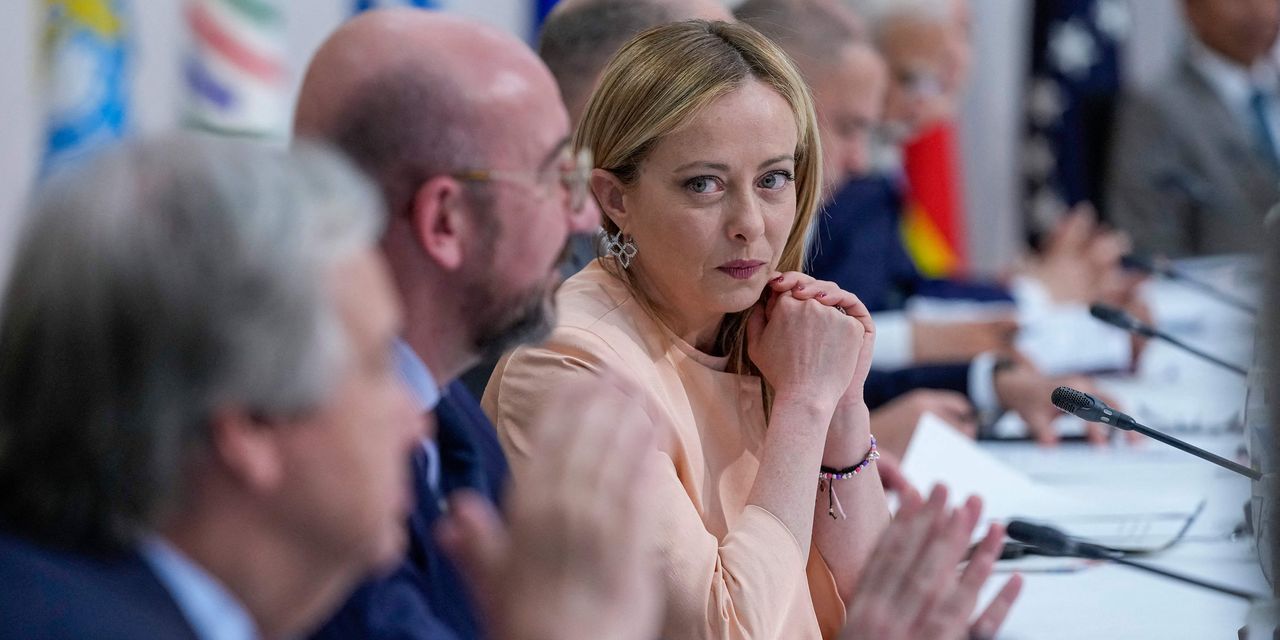Giorgia Meloni wasn’t elected to comfort the afflicted.
The Italian prime minister, who swapped her trademark white suit for jeans this past week to wade through flooded villages in the Emilia-Romagna region, swept to power last autumn on a right-populist platform of containing immigration, slashing taxes, and sticking it to the overbearing eurocrats in Brussels.
She hasn’t done much on any of these fronts. “So far, Meloni has been much ado about nothing,” says Kaspar Hense, a senior portfolio manager in fixed income at RBC BlueBay Asset Management.
That’s a good thing, from markets’ point of view. The yield spread of Italian 10-year bonds over German bunds, a key metric of investor confidence, has tightened by 45 basis points since Meloni’s Sept. 26 election, to below 200.
Standard & Poor’s and Moody’s lately maintained Italy’s credit rating at the lowest investment-grade rung, rather than reduce it to junk.
The
iShares MSCI Italy
exchange-traded fund (ticker: EWI) has rallied with the rest of Europe, gaining 40%. No. 2 bank
UniCredit
(UCG.Italy) has led the surge, rising by two-thirds.
Candidate Meloni promised 260 billion euros ($280.4 billion) in tax cuts, Hense says. Her first budget delivered €10 billion. Firebrand Meloni once signed a manifesto declaring “no to Europe.”
In office, she has toed the European Union line on Russia, and held off on pledges to turn back migrants from Italy’s shores.
“At a European level, she has sought to position Italy as a constructive mainstream partner,” says Eoin Drea, senior researcher at the Wilfried Martens Centre for European studies.
That’s all bowing to reality. With national debt around 140% of gross domestic product, Italy can’t afford to sacrifice tax revenue in a supply-side experiment. Playing nice with Brussels is only sensible when the country is in line for up to €200 billion from a European Recovery Fund raised postpandemic. Italy’s suffering from Covid-19 makes it the top potential recipient.
The Recovery Fund cash, due to be doled out by 2026, could add 4% a year to Italy’s GDP after decades of anemic growth, Hense calculates. If only the country can figure out how to spend it.
Previous governments proposed nonessential projects like a new soccer stadium in Venice, sapping Brussels’ confidence, Drea says. Meloni has floated a build-back-better shift to green energy and transportation. Chances of a credible pipeline by a June 30 deadline still look slight.
Success in drawing down recovery funds could give Meloni a shot at bigger structural changes, says Matt Gertken, chief geopolitical strategist at BCA Research.
Voters like the breath of fresh air she brings as Italy’s first female prime minister, and one of its youngest, at 46. Her coalition holds some 60% of both houses of parliament, and trounced a divided opposition in regional elections around Rome and Milan in February.
So, her government might last longer than most of its 67 predecessors since World War II. EU largess could provide fiscal space for her tax cuts.
Her personal example might get more Italian women into the workforce, a structural shot in the arm. Female labor participation languishes at 40%, compared with 51% in France and 56% in Germany.
Not that Gertken is betting on it. “Basically, Italy is hoping to muddle through and avoid a direct clash with Brussels,” he says. Hense predicts that the bond rally has peaked, and he has turned “cautious” on Italian paper.
“Muddle through” isn’t the worst that was expected from Meloni’s first half year, though.
Read the full article here


